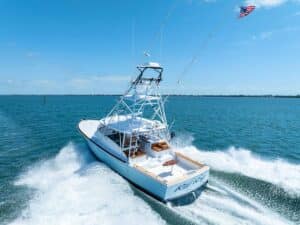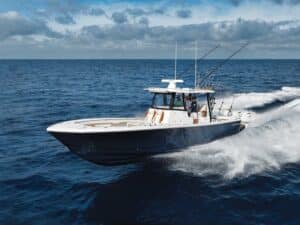
Selecting the right anti-fouling bottom paint will increase efficiency throughout your season and keep your overall maintenance costs down as well. Looking at the big picture, you should consider variables that influence the fouling situations in your areas of use. Boats that travel have different requirements from boats that mostly stay in the same area all year.
These variables include small differences in pollution, drainage outfalls, intrusion from fresh water, speed of water flow from the tide or natural current, and particularly, the amount of shade or sunlight the boat is in throughout the day when it is sitting at the dock, all of which will affect fouling growth. Different water qualities and temperatures create different types of fouling, such as barnacles, weeds, grass or slime.
Another consideration is how the boat is used. A boat that sits in a slip or is kept on a mooring will require a different bottom paint from a boat stored in a dry rack or living on a trailer. Is the boat kept in the water year-round, or is it hauled out after the summer season? Asking these questions when considering the type of anti-fouling needed will help you determine what specific products work for your specific situation.

Get the Right One
Choosing the correct product and having it applied properly will help keep growth to a minimum and reduce the amount of work your boat bottom requires. When changing bottom paints, you need to be sure that the new paint is compatible with what you have previously used. Some paints are not compatible, meaning your new paint will not work properly. Making sure your bottom surface is clean, smooth and properly prepared for good adhesion and coverage is key to getting the best life from your bottom paint.
Over time, your boat’s bottom can become rough, and the actual hull might need some attention; removing the old paint to expose the bottom surface is the best option. There are several ways to get there: good old-fashioned sanding, which is labor intensive, costly and time consuming; media blasting with sand or glass beads, which creates more work to be done to the surface once complete; or the popular soda blasting, which is less harsh on the surface and more environmentally friendly.

A Clean Start
Once clean of old paint and debris, the bottom can be examined for scars, holes, scratches and delamination that need to be addressed and filled with epoxy, then prepped for a barrier coat that is compatible with your manufacturer’s bottom paint. Products like Pettit Protect or Tie Coat Primer, and Interlux’s Interprotect products, are designed to help create a barrier for the hull surface to reduce osmotic blistering on gelcoats as well as create a good chemical bond with the bottom paint.
Manufacturers have invested a great deal in advancing their bottom-coat systems to give you the best life for your situation. The complex chemistry and development of cleaner, more environmentally friendly paints that are increasingly required by state and federal regulations are costly, but have yielded improved results for the environment and the bottom of your boat.
Several Choices
There are several different types of bottom paint, the most popular being a self-polishing copolymer (SPC), such as Interlux Micron 66. Not recommended for freshwater applications or for the do-it-yourselfer, SPC anti-foulings work because a patented resin reacts with salt water in a controlled way. The chemical reaction controls and sustains the release of biocides for the lifetime of the paint. This reaction takes place at the same rate whether your boat is underway or docked.
Another type of paint is an ablative, such as Pettit’s Ultima SR, Horizons and Vivid, and Interlux’s Fiberglass Bottomkote ACT and Pacifica Plus. Ablative paints wear away with use and need vessel movement to stay active. The paints wear in plates to expose fresh bottom paint, which helps reduce buildup, maintenance and preparation when it is time to reapply. Ablative paints can be applied over most other types of anti-fouling coatings.

Controlled solubility copolymers (CSC), such as Pettit’s Neptune 5 and Hydrocoat, and Interlux’s Micron Extra with Biolux and Micron CSC, are partially soluble. As water passes over the surface of the coating, the paint wears like a bar of soap — the more you use it, the smoother it gets — and it polishes itself with the boat sitting idle in the current. Water passing over the surface of the paint reduces its thickness at a controlled rate, always leaving the surface with fresh biocide throughout the season.
CSCs perform well in areas with high fouling characteristics, and their longevity is related directly to the applied thickness. These ablative-type paints are best for trailered boats because they can go in and out of the water and remain active. They also work on winterized boats, so they are also referred to as multiseason products. The hard anti-foulings, or contact-leaching types, such as Pettit’s Trinidad and Trinidad SR, Unepoxy, and Vivid, and Interlux’s Ultra-Kote, Ultra with Biolux and VC Offshore with Teflon, are anti-foulings that dry to a porous film imparted with biocides.

Controlled Release
The biocides in the paint leach out on contact with water, and the amount of biocide released steadily decreases as the season progresses until there is not enough biocide to prevent growth. Once the biocide is used up, the hard paint film remains on the boat. These paints do not retain their ability to prevent growth once they are out of the water, so they cannot be hauled and relaunched without being reapplied. The largest benefit to this type of paint is its ability to resist rubbing and abrasion, making it ideal for boats that have divers scrub their bottom regularly.
Bottom-paint manufacturers have multiple solutions to give you the best protection possible for longevity, color and durability, given your particular needs. With the right application and product, you will have better efficiency throughout your season and protect the subsurface of your boat, which is a critical part of your boat’s maintenance.







